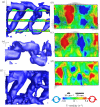Volumetric imaging of shark tail hydrodynamics reveals a three-dimensional dual-ring vortex wake structure
- PMID: 21543357
- PMCID: PMC3203501
- DOI: 10.1098/rspb.2011.0489
Volumetric imaging of shark tail hydrodynamics reveals a three-dimensional dual-ring vortex wake structure
Abstract
Understanding how moving organisms generate locomotor forces is fundamental to the analysis of aerodynamic and hydrodynamic flow patterns that are generated during body and appendage oscillation. In the past, this has been accomplished using two-dimensional planar techniques that require reconstruction of three-dimensional flow patterns. We have applied a new, fully three-dimensional, volumetric imaging technique that allows instantaneous capture of wake flow patterns, to a classic problem in functional vertebrate biology: the function of the asymmetrical (heterocercal) tail of swimming sharks to capture the vorticity field within the volume swept by the tail. These data were used to test a previous three-dimensional reconstruction of the shark vortex wake estimated from two-dimensional flow analyses, and show that the volumetric approach reveals a different vortex wake not previously reconstructed from two-dimensional slices. The hydrodynamic wake consists of one set of dual-linked vortex rings produced per half tail beat. In addition, we use a simple passive shark-tail model under robotic control to show that the three-dimensional wake flows of the robotic tail differ from the active tail motion of a live shark, suggesting that active control of kinematics and tail stiffness plays a substantial role in the production of wake vortical patterns.
Figures






References
-
- Hedenstrom A., Rosen M., Spedding G. 2006. Vortex wakes generated by robins Erithacus rubecula during free flight in a wind tunnel. J. R. Soc. Interface 3, 263–27610.1098/rsif.2005.0091 (doi:10.1098/rsif.2005.0091) - DOI - DOI - PMC - PubMed
-
- Spedding G., Rosen M., Hedenstrom A. 2003. A family of vortex wakes generated by a thrush nightingale in free flight in a wind tunnel over its entire natural range of flight speeds. J. Exp. Biol. 206, 2313–234410.1242/jeb.00423 (doi:10.1242/jeb.00423) - DOI - DOI - PubMed
-
- Tobalske B. W., Dial K. P. 2007. Aerodynamics of wing-assisted incline running in birds. J. Exp. Biol. 210, 1742–175110.1242/jeb.001701 (doi:10.1242/jeb.001701) - DOI - DOI - PubMed
-
- Warrick D. R., Tobalske B. W., Powers D. R. 2005. Aerodynamics of the hovering hummingbird. Nature 435, 1094–109710.1038/nature03647 (doi:10.1038/nature03647) - DOI - DOI - PubMed
-
- Hedenstrom A., Johansson L. C., Wolf M., von Busse R., Winter Y., Spedding G. R. 2007. Bat flight generates complex aerodynamic tracks. Science 316, 894–89710.1126/science.1142281 (doi:10.1126/science.1142281) - DOI - DOI - PubMed
Publication types
MeSH terms
LinkOut - more resources
Full Text Sources
Miscellaneous

